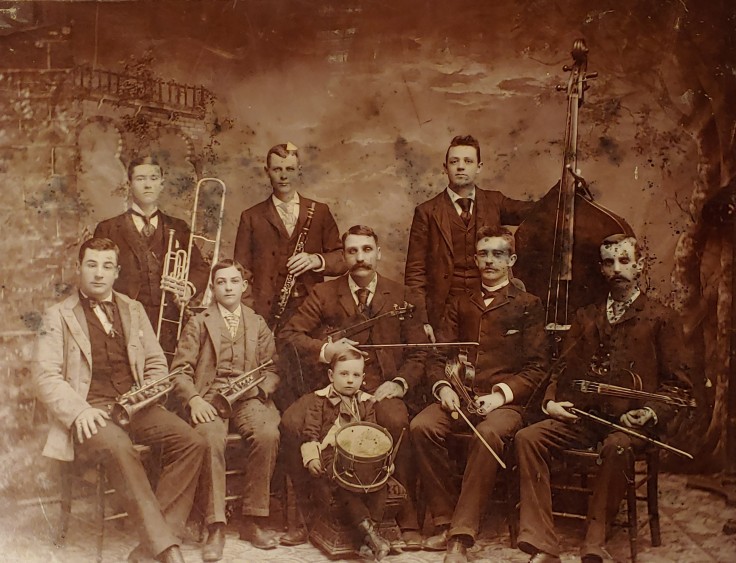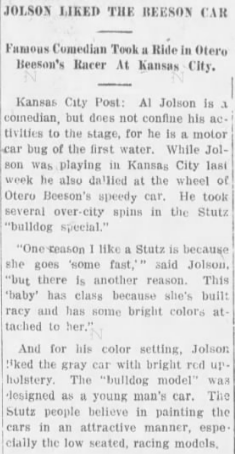My great-granduncle, Otero Gause Beeson, was the fifth and final child born to Chalk and Ida Beeson in September of 1889. I’ve been slowly excavating Uncle Ote’s (pronounced Oat-ee) unconventional existence for as long as I can remember. He was named after Chalk’s close friend and bandmate, Charles Otero.
They say the little drummer boy below began his musical instruction at age six and that may technically be true but he was exposed to a family of musicians from the very beginning.

As a youngster, Ote played traps and he experimented with the euphonium a bit before settling on the slide trombone. He didn’t take much seriously in life but when he turned 17, Ote joined the American Federation of Musicians Kansas City Local No. 34. Like his older brother, Ote attended Spalding’s Commercial College (President Truman’s alma mater) in Kansas City, which gave him access to world-class orchestras. He played at the Willis Wood, Gayety, and Globe theaters in addition to Electric Park, Excelsior Springs, Hotel Baltimore, and countless other venues.
In addition to music, Ote loved motorcycles and fast cars. His pride and joy was a 1915 Stutz Bulldog Special, which he had delivered on the rail in September of 1915…just a couple weeks after his 26th birthday.

I don’t know what this was all about but Ote was never going to stay in Dodge City. It was probably just a way to get a good deal on the car.

Ote raced the Stutz all over Hell’s half-acre and even Al Jolson took it for a spin in Kansas City.

1915 was also the year Merritt and Ote (mostly Merritt) built the Chalk Beeson Theater. As I noted in the theater post, the family basically conspired to install him as Manager so he would stop living like a professional musician. The plan backfired and Ote made a career of it.
As the US was entering WWI, Ote organized the Second Regiment Band and found himself stationed at Fort Sill in Oklahoma. In his book, Reminiscences of the 137th U. S. Infantry, C. E. Haterius described the day Ote failed his physical and was replaced by his close friend, Lou Fink, nicknamed “Sousa the Second” because he had played in Sousa’s Band and really was that good.

Ote suffered from rheumatism and the lack of effective treatments exacerbated his tendency to self-medicate. He was First Trombone in Arthur Pryor’s Band during the 1920-21 season at Royal Palm Park in Miami. The humidity aggravated his rheumatism, however, and he was quite relieved to return home. Ote spent a few winters playing in the Eastman Hotel house orchestra and found the climate in Hot Springs much more enjoyable.
The climate in Los Angeles was right up Ote’s alley. He had previously played in the Coronado Tent City Band but LA was where everyone from Kansas City seemed to migrate. Since Ote was a Mason and a Shriner, he had a social network ready and waiting. Letters of introduction from bandleaders in Kansas City also opened many doors.
Pianist, composer, and bandleader Sanford Smallfield was one of those Kansas City transplants. Smallfield’s sister-in-law, Kathleen Gleason, was one of Ote’s girlfriends. More on this fascinating family to come…

I’m sure you car people are wondering what the heck kind of car that is. Here’s the best guess I’ve seen so far. I initially thought it could be a Locomobile as well. That bumper really threw me.
Ote split his time mainly between Kansas City and Los Angeles from 1920 until 1940 with appearances around Kansas here and there in between. He occasionally played in (and sometimes led) the reorganized Dodge City Cowboy Band. Ote continued playing in the Million Dollar Band until the early 1940s when his failing health made it impossible.

My grandmother had this to say about Ote’s death in January of 1944:
“I always think of Ote as a good-time Charlie type. He was able to manage until the 1930s but from then on it was downhill all the way until 1944 when he died at home. A male nurse and family friend [Speck Madden] was with him for weeks. So very sad for us. The end.”
Irene Beeson

Leave a comment